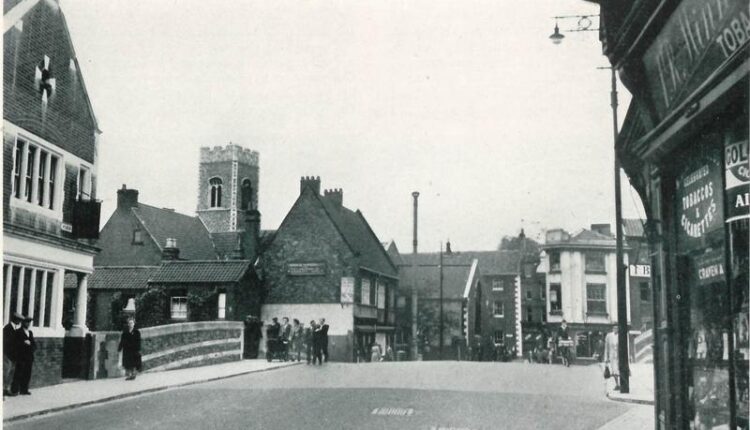Norwich’s Fye Bridge has a dark history.
Every day, hundreds of commuters and pub-goers pass by this old city icon. But Fye Bridge has a terrible history of mediaeval torture and retribution.
It is supposed to have been the site of a horrific device known as the ducking stool, which sealed the fate of many women accused of witchcraft. The stool was also used to punish disruptive ladies, scolds, and unscrupulous tradesmen.
Victims were tied to a chair and repeatedly immersed in the river below, a simple but terrifying device.
Illustration of a ducking stool from an 18th century chapbook, published in Chap-books of the Eighteenth Century by John Ashton (1834). (Image from Wikipedia)
In this example, the River Wensum, which runs beneath the old bridge, would have been used to ‘test’ unfortunate women accused of witchcraft.
Witches were said to be tied to chairs and repeatedly thrown into the river below. The notion was that if the woman survived the ducking, she was a witch who would be burned at the stake. If she drowned, her innocence was proven – at great cost.
The bridge is thought to house one of the city’s two stools, the other being at the Great Cockey, also known as ‘Jack’s Pit’, which is one of the city’s forgotten underground rivers known as ‘Cockeys’.
The blue tiles in the paving at Westlegate, in Norwich city centre which mark out the course of the Great Cockey(Image: Archant)
REIGN OF TERROR
Between 1644 to 1647, Matthew Hopkins, who claimed to be the Witchfinder General, unleashed fear in East Anglia.
Hopkins and his colleague John Stearne were responsible for more witchcraft executions than in the preceding century. Hopkin’s’swimming test’ was a version on ducking, with the idea that because witches had rejected their faith, the water would also reject them.
The Witchfinder was eventually informed that he could not use the swimming test without the approval of the person suspected of witchcraft. The practice ceased about the end of 1645.
The despot also utilised sleep deprivation to force confessions from alleged witches, as well as cutting them with a blunt knife to see if they bled and searching for the Devil’s Mark, which was thought to be present in all witches in the form of a birth mark, additional nipple, or mole.
NORWICH’S CONNECTION TO SALEM Bishop Bridge, built in 1340, is also linked to the unfortunate people who were ducked as witches.
Lollards Pit, located on the opposite side of the bridge, was used to draw chalk for the foundations of Norwich Cathedral. Just outside the city walls, it was the ideal site for individuals who had been expelled by the church to meet their demise.
Lollards were anti-clerical, and so-called heretics were burned on the site from the 1420s until Mary’s reign in the 16th century.
During the mid-17th century, it also became the site of witch burnings; more accused witches were hanged than burned, but a few met their flaming deaths at this location, which was visible from Bishop Bridge.
Built in 1340, the bridge was crossed by Robert Kett and his rebels in 1549, followed by Elizabeth I in 1578. Norwich is also thought to have ties to the notorious Salem witch trials.
The Bridge is between two city pubs, the Mischief and the Ribs of Beef(Image: Jack Warren)
Bridget Bishop, the first person executed during the Salem Witch Trials, was originally from Norwich and married her first husband, Samuel Wesselby, in the city.
Her second marriage was to Thomas Oliver, who had gone to Salem with his first wife Mary Leman, who was also thought to have been executed for witchcraft, after being deported and returning to Norwich.
Bridget and Thomas had a falling out after they married, and one of her stepchildren accused her of witchcraft.
She was acquitted and married Edward Bishop, but she was later convicted of witchcraft after being charged by five other Salem girls following a theft, and she was executed in 1692.
The Salem trials were modelled after Hopkins’ witch hunts in East Anglia.
HISTORY OF THE BRIDGE
The oldest bridge in the city is Fye Bridge, which connects Tombland and Magdalen Street. Records show that a timber structure was built in 1153. It was replaced by a stone variant in the early fifteenth century.
During the reign of Henry V, the bridge deteriorated and was destroyed by water in 1570. The current bridge, was opened in 1933, has two arches and a width of 50 feet between the parapets.
The Lollards Pit pub(Image: Archant)
THE FYE BRIDGE GHOST
Today, Fye Bridge is claimed to be haunted by the ragged spirit of a witch burned at Lollard’s Pit.
Those who have seen her describe her as being dressed in tatters and imploring strangers to assist her pick up a bundle of sticks used to start the fire in which she died.
It is said that people who support the spectre will perish in a fire within a year.
Read more on Straightwinfortoday.com


Comments are closed, but trackbacks and pingbacks are open.